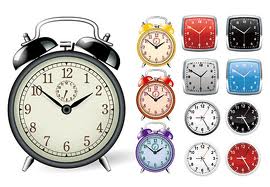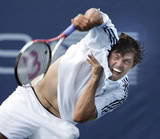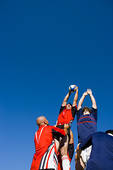- workout - tennis - multitask -
workouttennis.com was born chiefly through a German experience. Multitask was a big feature of German tennis life, both administratively and practically.
The origins of workouttennis.com
Tennis is not a public, or state-provided sport in Germany. So everyone working in tennis is a professional. A typical club coach has to do everything - teach juniors, hobby players and teams, participate in committees, do the courts and toilets, sell clothing and equipment, run fitness sessions, run his own business. If you couldn't multitask, you wouldn't survive, because the tennis environment demands it.

Time ticking away
Is this necessarily a good thing? Multitasking doesn't just happen in the tennis world. It is a modern phenomenon, heightened since the advent of computers. Through computers we have information overload and overspeed, which means it is expected that we are up to date, that we know quite a lot about lots of things.
Some of my criticisms, or compliments, about coaches, suggest that they have been very good specialists. They can only work for a certain group of players, and don't consider themselves to take on any other role than with that certain group. So there is always going to be a limit to their multitask capacity.
You simply cannot do everything, and there are people who do certain things very well, better than you. You may know a lot about it, you may dabble in it, but your speciality is something else. I am no different. Much as I multitask I know what my strengths are. Everyone should be aware of this as they go about structuring their careers. Exploit your strengths.

Find the power in you
Our business at workouttennis.com is creating very good tennis players, and a tennis player falls into this same multitask category.
If you look at the professional game you can see specialists, like a clay court player. He'll be set up for long rallies, spinning the ball a lot, and with great long distance running ability.
What happens if you have a great serve and penetrating flat groundstrokes, and, through fault of birth, you learn your tennis on clay with a load of specialists? You may end up playing like them, or worse, thinking you should be playing like them.
In the modern game, Feliciano Lopez is the anti-dote to a clay court player, but has struggled with concept and identity because he comes out of a rigid, typeset tennis culture. It could be the same for a young developing player. He must keep himself open to style and experience changes in order to establish, as quickly as possible, the areas that are going to take him furthest quickest.

Evaluate tour performance
If we look even closer into the daily life of a player, the multitask ethic must also be in place. Even though an organisation like workouttennis .com will take out a lot of the administrative and brainwork behind developing a player, a tennis player himself must be ready to do a variety of things.
He must be ready to eat different things at different times, learn to manage his sleep, rest and study. He must do exercises in the morning, and be aware of new exercises that may help certain areas of his body or psyche. He will do his tennis drills to develop technical comptence, but also strategic options. Every time his game develops technically, he will almost certainly need to make adjustments in other areas too. A player must accept this, and through his quest for exploit specialisation, remain open to everything, practise everything and keep tweaking the original plan.
Type of tennis player
In one area, the multitask ethic is less definable, or less logical, maybe less scientific. A fit tennis player will do exercises at home as an essential routine, he will hit balls for a couple of hours a day, and do some specific fitness drills on the tennis court. These drills should be tennis oriented.
There is also a last area - other sports, interests or pastimes. Just because you're a tennis player you should pursue other things you like doing as far as possible.
I have played almost all ball sports passionately, and I have been very lucky with injuries, gaining fitness and maintaining it for long periods although I have been moving so much. I firmly believe that a lot of this is exactly because I have always done other sporting things, in particular rugby, cricket, but at various other times, squash, cycling, football, skiing, and even including time for a long daily walk.

Tough sportsman
Some players may try and compensate for a lack of general sporting prowess, by increasing their fitness training on the tennis court, or maybe in the gym. In my experience though, these players have had general fitness problems, mostly to do with stamina, keeping injury-free, and remaining supple.
Medicine Ball
I'll just take an example which is based around a shot you don't play often - the backhand smash.
To execute this shot you need to jump, rotate hard, flick your wrist to its extremes, and put unusual twisting actions on certain areas of your body that don't often have this - your neck, knees and shoulders. On the face of it, this is a shot that could get you a nasty injury. Some players will argue that they just need to practise the shot. To a point that is true, but by playing other sports, you automatically train your body to play that OTHER shot, the one that the normal tennis player cannot, won't do. He won't do it, because he doesn't have the confidence to let his body handle anything that comes his way.
workouttennis.com recommends all players be active. Hitting too many tennis balls can lead to overkill, stifling creativity and natural development.
A life, a mind and a body need variety, and often planned, but flexible variety. Lots of different sports should be on the agenda, studying too, or developing personal interests. All of this will back up a personal quest for identity on the tennis court. The multitask gets you there quicker.
